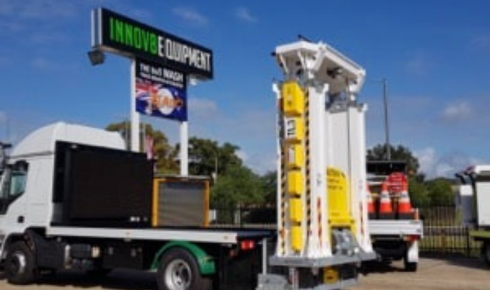Learn about the INNOV8 Equipment Blade Attenuator, a cutting-edge solution for roadside protection. This article delves into the features and benefits of this innovative technology, exploring how it enhances safety on the roads and mitigates potential risks for drivers and pedestrians.
Importance of Roadside Safety
Roadside safety is of utmost importance to ensure the well-being of both motorists and pedestrians. Proper maintenance and design of roadsides can significantly reduce the risk of accidents and injuries. Clear signage, barriers, and proper lighting can help drivers navigate safely, especially during adverse weather conditions or at night. Additionally, well-maintained shoulders and clear visibility can provide a safe refuge for drivers in case of emergencies or breakdowns. Ensuring adequate road markings and reflective materials can enhance visibility and reduce the chances of collisions. Overall, prioritizing roadside safety measures can contribute to a safer and more efficient transportation system for all road users.
Moreover, the importance of roadside safety extends beyond just preventing accidents. Well-designed roadsides can also improve the aesthetic appeal of the surroundings, contributing to the overall quality of life in a community. Proper landscaping and maintenance of roadside areas not only enhance the visual appeal but also promote environmental sustainability. By incorporating green spaces, trees, and vegetation along roadsides, communities can mitigate environmental impacts such as noise pollution, air pollution, and erosion. Roadside safety measures can also support active transportation options like walking and cycling, encouraging healthier lifestyles and reducing dependence on motor vehicles. In essence, investing in roadside safety is essential for promoting safety, sustainability, and quality of life in our communities.
INNOV8 Equipment provides essential traffic-management solutions, enhancing roadside safety with their advanced equipment. Serving Australia and New Zealand, they ensure compliance with safety standards while supporting construction, mining, and civil sectors. Their innovations contribute significantly to community well-being and environmental sustainability.
Evolution of Blade Attenuators
The evolution of blade attenuators represents a significant advancement in the field of road safety and traffic management. Blade attenuators, also known as crash cushions or impact attenuators, are devices installed at the end of concrete barriers or guardrails to absorb the impact of a vehicle in the event of a collision. Over the years, the design and materials used in blade attenuators have evolved to enhance their effectiveness in reducing the severity of crashes and protecting motorists and passengers. The early blade attenuators were typically made of steel or concrete and were effective in reducing the impact on vehicles. However, advancements in technology and research have led to the development of more innovative and efficient blade attenuators.
Modern blade attenuators now incorporate a combination of materials such as steel, aluminum, foam, and plastic to improve their crashworthiness and energy absorption capabilities. These newer designs are engineered to deform upon impact, dissipating the kinetic energy of the vehicle and reducing the risk of injury to the occupants. Furthermore, the shape and configuration of blade attenuators have been optimized through extensive testing and simulations to ensure their performance in various collision scenarios. The evolution of blade attenuators continues to focus on improving safety standards on roadways by offering robust protection to motorists and minimizing the impact of crashes on infrastructure.
Overview of INNOV8 Equipment
INNOV8 Equipment is a leading provider of innovative and high-quality industrial equipment designed to improve efficiency and productivity in various industries. The company offers a wide range of equipment, including material handling solutions, industrial automation systems, and environmental control systems. With a focus on cutting-edge technology and advanced engineering, INNOV8 Equipment strives to stay at the forefront of industry trends and provide its customers with innovative solutions to meet their specific needs. The company’s equipment is designed to enhance operational processes, streamline workflows, and optimize production outputs, making it a preferred choice for businesses seeking to improve their overall performance and competitiveness.
INNOV8 Equipment prides itself on its commitment to quality, reliability, and customer satisfaction. The company’s products undergo rigorous testing and quality control measures to ensure they meet industry standards and exceed customer expectations. INNOV8 Equipment also offers comprehensive support services, including installation, training, and maintenance, to ensure that customers can maximize the benefits of their equipment. With a team of experienced engineers and technical experts, INNOV8 Equipment is dedicated to providing personalized solutions and exceptional service to its clients. Whether it’s optimizing material handling processes or implementing advanced automation systems, INNOV8 Equipment is a trusted partner for businesses looking to drive innovation and efficiency in their operations.
Advantages of Blade Attenuators
Blade attenuators offer several advantages in the field of noise control and reduction. Firstly, blade attenuators are highly effective in reducing noise levels across a wide range of frequencies. The design of the blades allows them to break up sound waves and scatter the noise, leading to a significant decrease in noise levels. This makes blade attenuators particularly useful in environments where noise pollution is a concern, such as industrial facilities, HVAC systems, and transportation infrastructure. Additionally, blade attenuators can be customized to specific noise reduction requirements, allowing for tailored solutions to effectively address noise issues in various settings.
Another advantage of blade attenuators is their versatility and adaptability to different applications. Blade attenuators can be installed in various configurations, such as as standalone units, in ductwork systems, or integrated into machinery and equipment. This flexibility makes blade attenuators suitable for a wide range of industries and settings, providing effective noise control solutions without compromising the overall efficiency of the system. Furthermore, blade attenuators are durable and low maintenance, offering long-term cost savings and reliable noise reduction performance. Overall, the advantages of blade attenuators make them a valuable tool in mitigating noise pollution and creating more comfortable and productive environments.
INNOV8 Equipment blade attenuator exemplifies this versatility, offering advanced solutions for noise control in traffic management. Serving Australia and NZ, INNOV8 designs durable, low-maintenance attenuators that ensure safety and efficiency, supporting construction, mining, and civil sectors with innovative, cost-effective products.
How the Blade Attenuator Works
The Blade Attenuator is a sophisticated device used in engineering and construction projects to control the flow of fluid or gas within a pipeline system. Its functionality is based on the principle of blade orientation and positioning. The attenuator consists of a series of blades that can be adjusted to varying angles, allowing for precise regulation of the fluid or gas passing through the system. By altering the angle of the blades, the flow rate and pressure within the pipeline can be effectively controlled. This mechanism enables operators to manage the flow dynamics according to specific requirements, such as maintaining a consistent flow rate, reducing pressure surges, or shutting off the flow completely when needed.
The Blade Attenuator operates through a combination of hydraulic, pneumatic, or mechanical systems, depending on the application and design of the device. When the blades are set at an optimal angle, they create resistance to the flow of fluid or gas, effectively attenuating the pressure and controlling the flow rate within the pipeline. This precise control mechanism allows for the efficient operation of the pipeline system, ensuring that the fluid or gas is conveyed smoothly and safely without any disruptions or irregularities. The Blade Attenuator’s ability to fine-tune the flow dynamics makes it a valuable tool in various industries, including oil and gas, water treatment, and manufacturing, where precise control over fluid flow is essential for operational efficiency and safety.
Installation and Maintenance Procedures
Installation and maintenance procedures are crucial aspects of ensuring the efficient operation and longevity of various equipment and systems. During the installation process, it is essential to follow manufacturer guidelines and best practices to ensure that the equipment is set up correctly. This may involve tasks such as assembly, wiring, calibration, and testing to ensure that the equipment is functioning as intended. Proper installation procedures not only ensure the equipment operates efficiently but also contribute to its safety and reliability.
Maintenance procedures are equally important in preserving the performance and lifespan of equipment. Regular maintenance, such as inspections, cleaning, lubrication, and component replacement, helps prevent unexpected breakdowns and costly repairs. Following a maintenance schedule provided by the manufacturer or industry standards can help identify potential issues early and address them before they escalate. Proper maintenance procedures not only extend the life of equipment but also ensure it continues to operate safely and at optimal performance levels. Overall, installation and maintenance procedures play a critical role in the reliability, safety, and efficiency of equipment and systems.
Case Studies: Successful Implementations
Case studies are powerful tools that showcase real-world success stories of how a particular product, service, or strategy has been implemented successfully. These case studies provide valuable insights into the challenges faced, the strategies employed, and the outcomes achieved, making them essential resources for businesses looking to learn from the experiences of others. Successful case studies often highlight the innovative approaches taken by companies to solve complex problems, demonstrating the creativity and ingenuity required to achieve success in a competitive business environment. By studying these successful implementations, organizations can gain inspiration, ideas, and practical tips to apply to their own projects, helping them to avoid common pitfalls and optimize their chances of success.
One key aspect of successful case studies is the emphasis on measurable results and tangible outcomes. By providing concrete data and metrics, these case studies offer a clear picture of the impact of a particular initiative or strategy, allowing other businesses to assess the potential benefits and risks of implementing a similar approach. Additionally, successful case studies often delve into the specific steps taken by companies to ensure successful implementation, including stakeholder engagement, resource allocation, risk management, and monitoring and evaluation processes. By examining these details, organizations can learn valuable lessons about the importance of strategic planning, effective communication, and continuous improvement in achieving successful outcomes.
Comparison with Traditional Attenuation Systems
Traditional attenuation systems, such as stormwater ponds and swales, have been commonly used to manage stormwater runoff and reduce flooding in urban areas. While these systems have been effective to some extent, they often have limitations that make them less efficient and sustainable compared to modern green infrastructure solutions. One key difference is in their ability to provide multiple benefits beyond flood control. Green infrastructure systems, such as bioswales, permeable pavements, and green roofs, not only reduce stormwater volume but also improve water quality, enhance biodiversity, and provide aesthetic and recreational benefits. In contrast, traditional attenuation systems mainly focus on flood control without addressing other environmental and social needs of urban areas.
Another important aspect to consider when comparing modern green infrastructure with traditional attenuation systems is their cost-effectiveness and long-term maintenance requirements. While traditional systems may have lower upfront costs, they often require regular and costly maintenance to ensure their effectiveness over time. Green infrastructure, on the other hand, can be more cost-effective in the long run as they require less maintenance and can provide additional benefits that contribute to the overall well-being of communities. Additionally, green infrastructure solutions are often more flexible and can be easily integrated into existing urban landscapes, making them a more versatile and sustainable option for managing stormwater runoff in urban areas.
Safety Standards and Regulations
Safety standards and regulations are crucial in ensuring the well-being of individuals in various settings, such as workplaces, public spaces, and transportation systems. These standards are established by government agencies, industry organizations, and international bodies to minimize risks and hazards that could pose a threat to people’s health and safety. Compliance with safety standards is essential for organizations to create a safe environment for employees and customers, as well as to avoid legal liabilities and financial losses resulting from accidents or injuries. Safety regulations cover a wide range of areas, including equipment safety, fire safety, electrical safety, chemical handling, and emergency preparedness. By adhering to these standards, organizations demonstrate their commitment to prioritizing the health and safety of their stakeholders.
Enforcement of safety standards and regulations is typically carried out through inspections, audits, and penalties for non-compliance. Government agencies, such as the Occupational Safety and Health Administration (OSHA) in the United States, play a key role in monitoring and enforcing safety regulations in various industries. Inspections ensure that workplaces adhere to safety guidelines, provide necessary training to employees, and maintain proper safety equipment. Organizations that fail to meet safety standards may face fines, sanctions, or legal actions, which can have a significant impact on their reputation and financial stability. Therefore, it is essential for businesses to stay informed about the latest safety regulations and invest in measures to maintain a safe and healthy environment for their workforce and customers.
Future Developments in Roadside Protection Technology
Future developments in roadside protection technology are poised to revolutionize safety measures for both drivers and pedestrians. One significant advancement is the integration of smart sensors and artificial intelligence in roadside barriers. These barriers will be equipped with sensors that can detect approaching vehicles and adjust their position or stiffness to effectively absorb impact energy in case of a collision. Moreover, AI algorithms will enable these barriers to analyze real-time traffic data and predict potential accident scenarios, allowing them to proactively deploy safety measures to minimize the impact of accidents.
Another exciting development is the use of advanced materials in roadside protection systems. Engineers are exploring the use of materials like carbon fiber composites and shape memory alloys to create barriers that are not only stronger and more durable but also lightweight and flexible. These materials can be designed to deform upon impact and then return to their original shape, reducing the need for frequent maintenance and replacement. Additionally, the incorporation of self-healing materials in roadside barriers can further enhance their longevity and effectiveness in protecting road users. Overall, future developments in roadside protection technology hold great promise in significantly improving road safety and reducing the severity of accidents.



